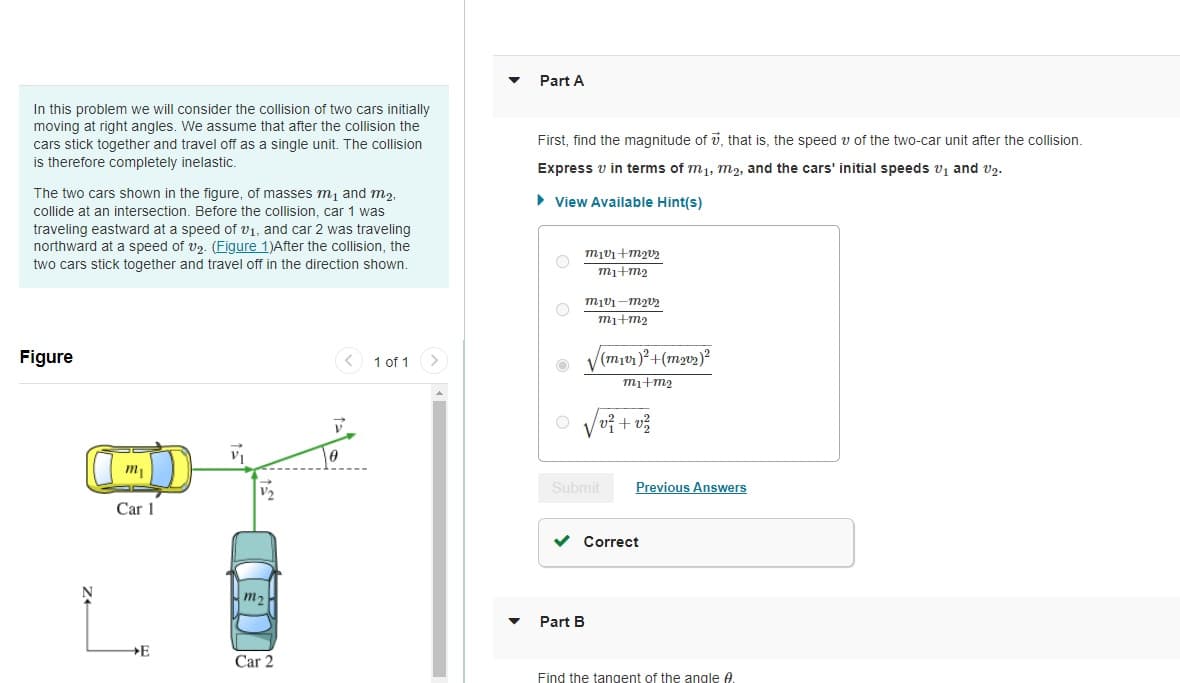In this problem we will consider the collision of two cars initially moving at right angles. We assume that after the collision the cars stick together and travel off as a single unit. The collision is therefore completely inelastic. The two cars shown in the figure, of masses m₁ and m₂. collide at an intersection. Before the collision, car 1 was traveling eastward at a speed of ₁, and car 2 was traveling northward at a speed of 2. (Figure 1)After the collision, the two cars stick together and travel off in the direction shown. Figure m₁ Car 1 E M₂H Car 2 0 1 of 1 Part A First, find the magnitude of 7, that is, the speed of the two-car unit after the collision. Express v in terms of m₁, m₂, and the cars' initial speeds ₁ and v₂. ► View Available Hint(s) O m1v1+m2v2 mi+m₂ 11-22 m₁+m2 Part B (m₁)²+(m₂v₂)² m₁+m₂ v² +v²/² Submit Previous Answers Correct
I think my problem with this question is the algebra. I think everything was under the square root at some point in the problem due to the pythagorian theorem. I'm confused about how it went from all being under the square root to only the top portion being under the square root.

Trending now
This is a popular solution!
Step by step
Solved in 2 steps with 2 images

Never mind. I see it now. You don't add the denominator together. Sheesh!
I think you don't understand my question. Let me try this one more time with equations.

That still doesn't answer my question. How did you take (m1 + m2)2 + (m1 + m2)2 and get (m1 + m2)2. Where did the extra (m1 + m2)2 go? There were two of them. Now there's suddenly one. That's the step I've been confused about since the beginning. I understand the physics. I'm having a problem with the algebra.
Hi. I still don't get it. I'm not sure what sin and cos have to do with it. But either way, I'm still stuck in the same place.
I don't know how you got from steps 3 and 4 to the next step. One is for the x-axis and the other for the y-axis. How did they end up merged together?
If you apply the Pythagorean theorem, you get either:
v = sqrt{(vcos) 2 + (vsin) 2} Then what?
Or you get:
v = sqrt{(m1v1/m1+m2)2 + (m2v2/m1+m2)2} Now what?
That "adding" step just looks like the Pythagorean theorem, with v2 being the c in c2 = a2 + b2, but what is going on on the other side of the equation?
I don't understand how in the denominator you went from:
(m1 + m2)2 + (m1 + m2)2 to
(m1 + m2)2
It seems to me like (m1 + m2)2 + (m1 + m2)2 = 2(m1 + m2)2
Explain as if I didn't understand the algebra, because I think that's the issue here.






